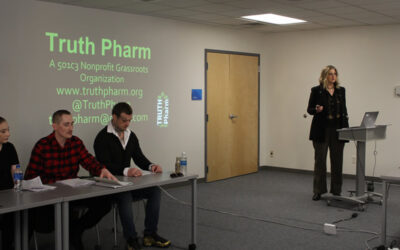SCIENCE OF ADDICTION
Addiction is a Chronic Brain Illness
Symptoms
Devastating changes in behavior where even under threat of the most severe of punishments, one cannot stop using the substance.
Affected area of the Brain
THE REWARD CENTER is the most primitive part of our brain (ancient lizards had this part of the brain). It tells you every day to find food, find clean water and find a mate; because your only real job on this planet from an evolutionary standpoint is to survive long enough to procreate. The drive you have to engage in these behaviors is mediated by the neurotransmitter dopamine; without it, you die. The problem: it’s this “am going to live today, or am I going to die today?” part of the brain that is impacted by every substance of abuse.
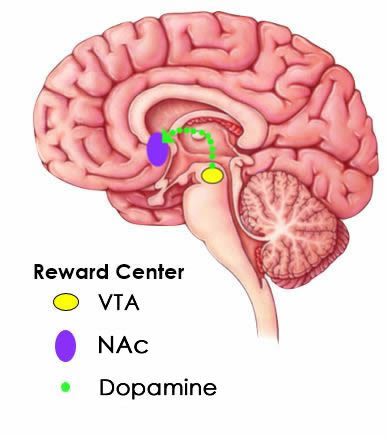
The Dopamine Pathway
Dopamine is made in the Ventral Tegmental Area (VTA) and received in the Nucleus Accumbens (NAc) – see diagram. This results in feelings of euphoria and provides you motivation to continue actions that release the dopamine. There are two main behaviors associated with this pathway:
- compulsion: I do it over and over again.
- perseveration: I think about it all the time (obsession).
Long before supermarkets and mini-marts, food was scarce. Our ancestors had to be very compulsive about getting food and they needed to plan and think about it all the time. These behaviors were important for their survival. Because substances of abuse stimulate this pathway better than any natural reinforcers, and getting them becomes the primary focus of those behaviors.
How does Addiction Develop?
1) Relevance of Dopamine
When we engage in pleasurable behavior, spikes in dopamine occur. These spikes positively reinforce us to continue these behaviors.
An example of how this works is shown in the diagram at the right. Most of us have a baseline dopamine level of “100” against which we measure increases and decreases. If you get your perfect food item your dopamine will spike to 150 and return right back to baseline. It is an evolutionary intention that our dopamine is elevated; this positively reinforces pleasurable behavior such as eating, having sex or listening to music and incites our brains to form powerful memories of them.
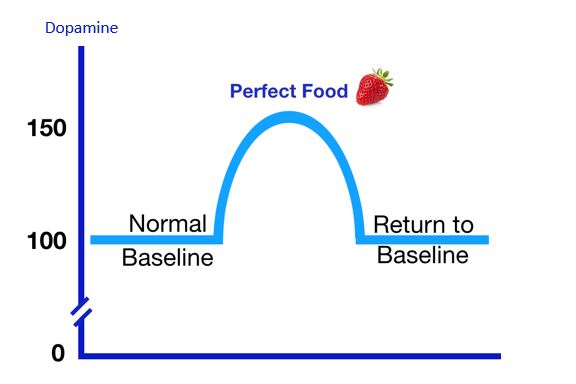
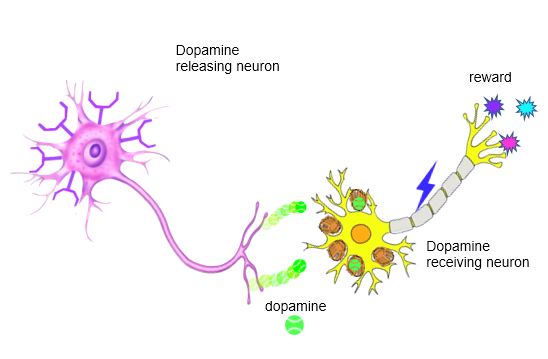
The dopamine signal is mediated by neurons. One neuron releases dopamine and another receives the dopamine. When that happens, an electrical pulse is sent down the receiving neuron which gives you your reward.
Three mechanisms the brain uses to regulate the dopamine signal.
- How much dopamine it releases
- How many “hands” (receptors) it has to receive the dopamine
- How much dopamine is re-absorbed/degraded (lowers the amount of dopamine available)
2) Substances of Abuse Raise
Dopamine to Abnormal Levels
Substances of abuse raise our dopamine much higher than natural reinforcers.
Some substances of abuse raise dopamine as much as 5-6 times higher than natural reinforcers (as the graph on the right shows). When this happens, the reward center in our brain recognizes it as terribly wrong and immediately strives to correct it.

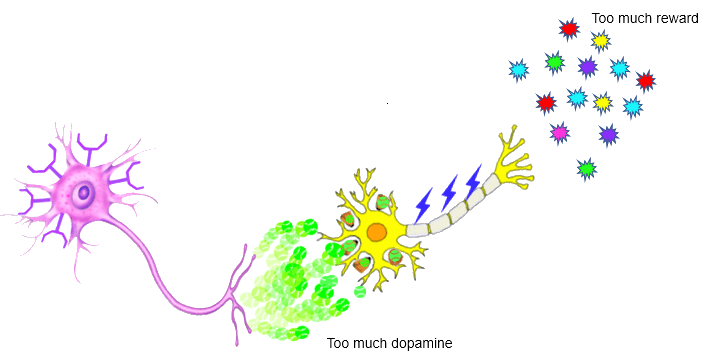
3) How the Brain Responds to Abnormal
Levels of Dopamine
As mentioned above, there are three main ways that our brains regulate dopamine:
- how much dopamine it releases
- how many receptors are able to receive the dopamine
- and how much dopamine it will reabsorb/degrade
When the brain experiences abnormally high levels of dopamine it will:
burn up 80% of receptors

Inhibit the release of dopamine

Increase the reuptake and degradation of dopamine

Let’s Graph this out
Remember the healthy brain:
It wakes up with baseline dopamine of 100, it gets its favorite food item, it spikes to 150 and then comes back to baseline

The brain developing addiction:
It gets its first drug high, say 900 with heroin, and with repeated administration, it doesn’t get to 900 again, it may get to 880 then 850, 800, etc. But the real problem isn’t that the person isn’t reaching previous high levels of dopamine. The problem is that when that person wakes up in the morning, they are no longer at baseline 100… their baseline bottoms out, and they wake up at dopamine levels of maybe 30 or 40.

The Result?
When dopamine levels are at 30 or 40 it is hard to function:
It is hard to get out of bed. The brain feels awful and it knows it needs dopamine. No natural reinforcer will appreciably raise the dopamine levels and the person will use every single resource available to satisfy this “am I going to live today or am I going to die today?” part of the brain. There is only one thing that will raise dopamine enough to function, and that is the drug, and the brain knows this and will fixate on getting it with the obsession and compulsion hardwired into this survival pathway.
The Reward Center of the Brain isn’t the Only Target!
The prefrontal cortex is highly dependent on dopamine for proper functioning. A small list of functions are:
- ability to plan ahead
- predicting consequences
- impulse control
- coordinating complex behaviors (I can’t do “X” before “Y” happens)
All executive functioning relies on the proper functioning of the prefrontal cortex. Its ability to function is dependent on dopamine; so while the disruption to the reward center explains why there is an intense drive to seek out the desired drug to raise dopamine, the deprivation of dopamine to the PFC explains why reasoning and logic cannot appeal to the person suffering SUD.
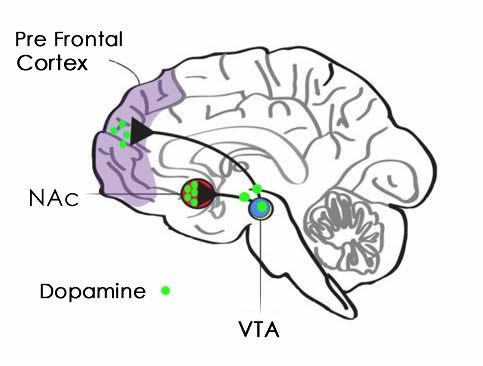
FOR MORE INFORMATION
LATEST NEWS
Truth Pharm Advocates Against Supplantation of Opioid Settlement Funds
We had an incredibly productive day in Albany yesterday! Several legislators did not know that...
Jeff’s Birthday
Jeff’s birthday was Sunday and it’s extra monumental as this marks the 10th year since his last...
Truth Pharm Delivers Presentation at Lourdes Hospital
On December 15, Truth Pharm led a presentation at Lourdes Hospital as part of the See Me, Hear Me,...
LOCATIONS
East Coast
- Southern Tier
- Southern Chenango County Recovery Resources
- Sherburne-Earlville
West Coast
- Los Angeles
CONTACT
Truth Pharm, Inc
PO Box 424
Binghamton, NY 13902
49 Pine St. Suite 6
Binghamton, NY 13901
607-296-3016
info@TruthPharm.org


